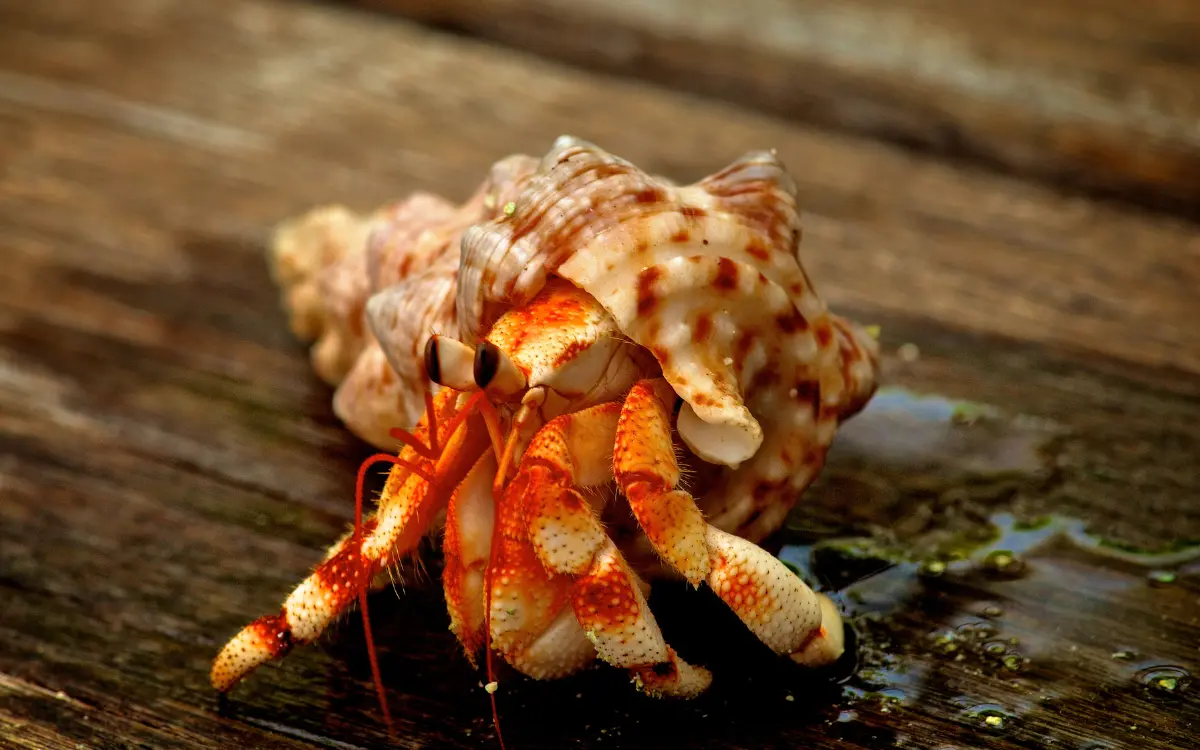There are many types of hermit crabs. Interestingly, 800+ species are recognized as hermit crabs. However, a few of them are kept as pets. Caribbean hermit crabs, Ecuadorian hermit crabs, strawberry hermit crabs, and Australian hermit crabs are the most popular pet hermit crabs. Each type of hermit crab has its unique characteristics.
So, it is important to research the specific species and their types before getting one as a pet. In this way, you’ll give them proper care, diet, and environment to let them live a healthy and happy life. In this article, I’m going to touch all types of hermit crabs to help you choose which one can become part of your home. 🦀
Let’s enjoy reading this entire research!
What are the Types/Species of Hermit Crabs?
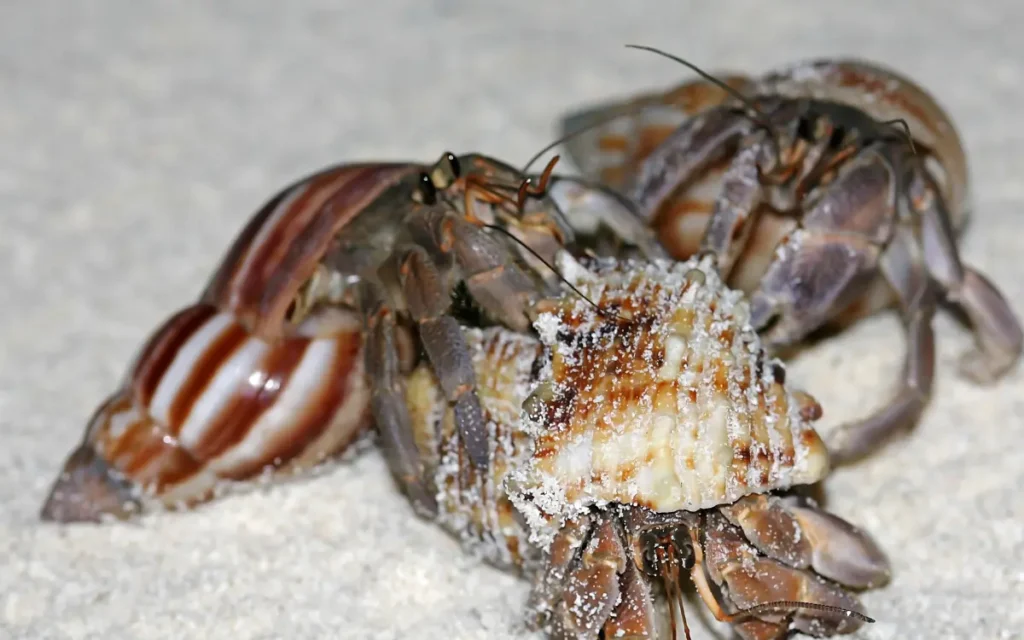
Hermit crabs are social animals and people love to pet them. But do you know which type of hermit crab you are owning? Are all hermit crabs the same?
Let’s see what’s the truth!
But, before diving deep into the thought-provoking information, keep an eye on the quick review table given below:⤵️
| Parameters: | Description: |
| Kingdom: | Animalia |
| Temporal range: | Hettangian–Present |
| Domain: | Eukaryota |
| Phylum: | Arthropoda |
| Class: | Malacostraca |
| Order: | Decapoda |
| Suborder: | Pleocyemata |
| Infraorder: | Anomura |
| Superfamily: | Paguroidea(Latreille diagnosed it in 1802) |
| Families List: | There are 8 recognized and verified families in which hermit crabs are divided. These are 1.Pylochelidae 2.Pylojacquesidae 3.Paguridae 4.Parapaguridae 5.Parapylochelidae 6.Calcinidae 7.Coenobitidae 8.Diogenidae |
| Division: | Aquatic hermit crabs and land hermit crabs |
How many types of hermit crabs are present in this world?
According to the research of “National Geographic” and “The Hermit Crabs Association”, there are 800 to 1,000 types (or species) of hermit crabs found now. And many other types of hermit crabs are still under review. Thus, there are hundreds of known species of hermit crabs and there are many unknown species hidden from our eyes.
Interestingly, scientific studies show that the above-mentioned eight families contain more than 1100 species. And, hermit crabs are divided into 120 genera due to the large number of species. Let’s see which family of hermit crabs have how many genera in the given table:👇
| Which family? | Who Diagnosed? | When Diagnosed? | How many genera? |
| Calcinidae: | Fraaije, Van Bakel & Jagt | 2017 | 7 |
| Coenobitidae: | Dana | 1851 | 2 (Coconut Crab & Terrestrial Crab) |
| Diogenidae: | Ortmann | 1892 | 20 (left-handed hermit crabs) |
| Paguridae: | Latreille | 1802 | 76 genera |
| Parapaguridae: | Smith | 1882 | 10 genera |
| Parapylochelidae: | Fraaije and others. | 2012 | 2 genera |
| Pylochelidae: | Bate | 1888 | 9 genera (symmetrical hermit crabs) |
| Pylojacquesidae: | McLaughlin & Lemaitre | 2001 | 2 genera |
If you want to learn more about hermit crabs, you can check out the following links:
Groups of Hermit Crabs:
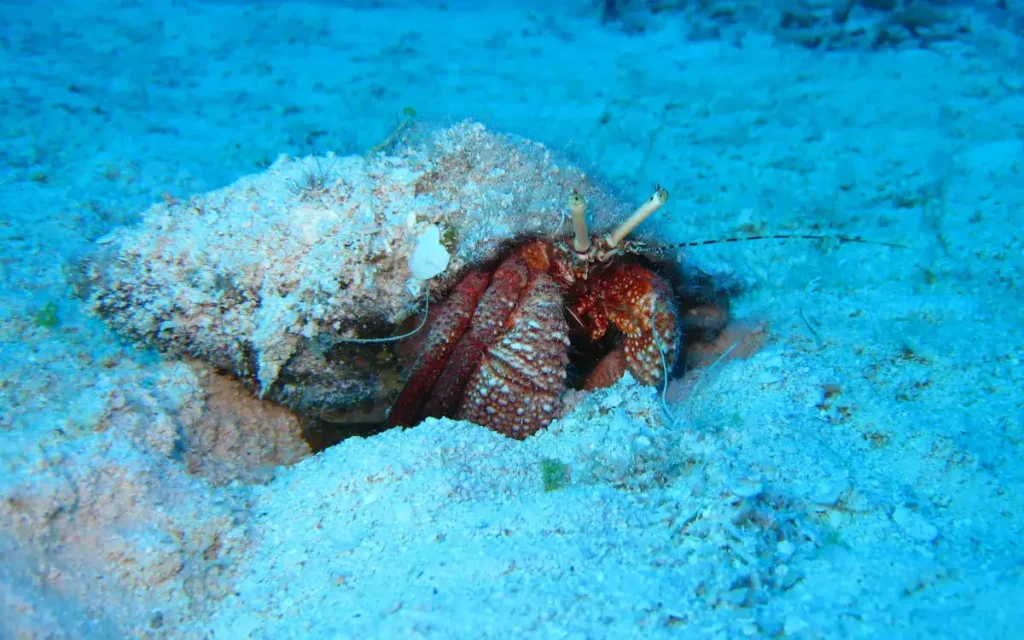
If we divide hermit crabs into groups, there are only two groups of hermit crabs: Aquatic (or Marine) hermit crabs and land hermit crabs. Let’s see a brief overview of what’s the difference between both groups of hermit crabs.
| Aquatic Hermit Crabs | Land Hermit Crabs |
| Have multicolored, striped, or spotted legs. | Have solid-colored legs, usually red or purple. |
| Have shells that are often covered in barnacles. | Have shells but they are not covered in barnacles. |
| Live in saltwater environments, such as coral reefs and intertidal areas. | Live on land, mostly in tropical locations near the sea. |
| Breathe water through their gills. | Breathe air as long as their gills are moist. |
| Cannot survive on dry land for a long time. | Cannot survive underwater for more than 20 to 30 minutes. |
| Mate and release eggs in the water. | Mate and release eggs in the ocean. |
| Are less commonly found as pets. | Are more commonly found as pets. |
| Have a modified appendage called a branchiostegal lung that helps them breathe water. | Have a modified appendage called a scaphognathite that helps them breathe air. |
| Have a pair of antennules that are used for detecting chemical signals and finding mates. | Have a pair of antennae that are used for sensing the environment and communicating with other hermit crabs. |
| Aquatic hermit crabs have a pair of eyes that are located on the front of their heads. Their eyes cannot be retracted. | Land hermit crabs have a pair of eyes that are located on stalks. Their eyes can be retracted into their shells. |
| They have a soft abdomen that is symmetrical. Plus, it is straight to fit into their shells. | They have a soft abdomen that is asymmetrical. Moreover, it is twisted to fit into their shells. |
| Marine hermit crabs have a diet of algae, plankton, and small animals. | These types of hermit crabs have a diet of plant matter, fruits, nuts, and carrion. |
Important Note: The intent of discussing the differences between both types of hermit crabs is very clear. It will help you to take care of your hermit crab in the future if you decide to have one or more!
Now, let’s discuss both groups/ types of hermit crabs in detail.
- Aquatic Hermit Crabs:
The species that fall under aquatic hermit crabs live in marine or freshwater. These types of hermit crabs spend most of their time under the salted water from shorelines and shallow reefs to deep sea bottoms. Interestingly, they rarely try to leave their watery habitat for land.
Do you know aquatic hermit crabs breathe through their gills just like other aquatic creatures? However, most of the aquatic hermit crabs can survive out of water until their gills are damp. Otherwise, they’ll die!
Read also: How To Set Up A Crabitat: Beginner’s Guide
List of Popular Aquatic/Marine Hermit Crabs:
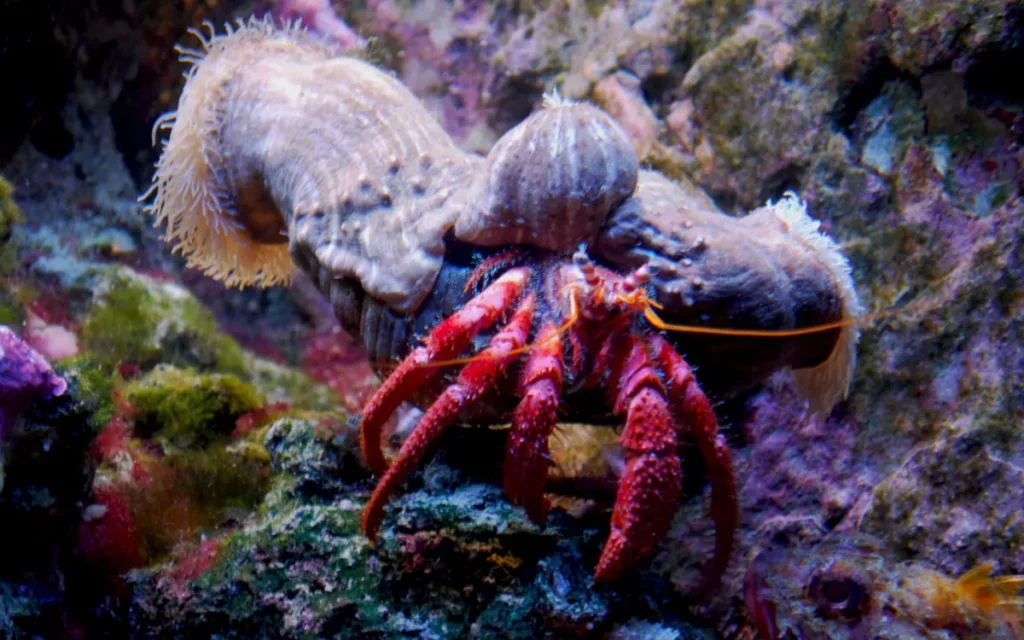
Here is the list of the most popular aquatic hermit crabs:
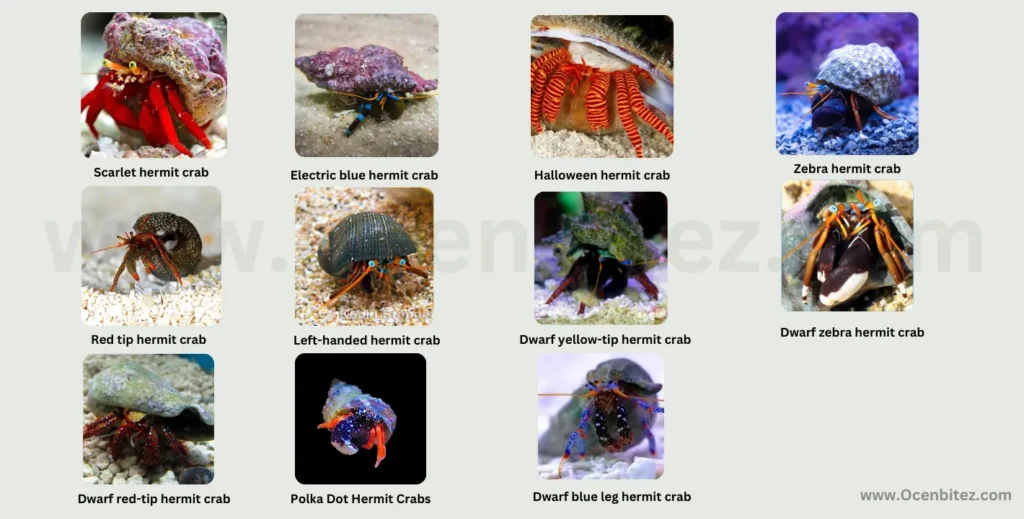
1.Scarlet hermit crab (Paguristes cadenati)
Scarlet hermit crabs are scientifically known as Paguristes cadenati. These little guys got their name from the vibrant red-orange coloring in their bodies and hence called “Scarlets.” These types of hermit crabs are found in the Western Atlantic Ocean and the Gulf of Mexico.
Like other hermit crabs, Scarlet hermit crabs have a soft (or vulnerable) abdomen. So, they inhabit empty shells of snails or other mollusks in order to protect themselves from predators and hard environments. These shells are the portable homes that they carry around them wherever they go.
Interesting Fact!
Scarlet hermit crabs are known as aggressive crabs. You’ll find them quarreling and competing with each other for shells. Sometimes, one crab forcibly evicts another from its shell.
That’s the reason why aquarists and hermit crab enthusiasts avoid keeping Scarlet hermit crabs in their fish tanks. However, their ability to help control algae growth in aquariums is matchless.
2.Electric blue hermit crab (Calcinus elegans)
Let’s meet with another one of the famous types of hermit crabs – electric blue hermit crabs. Let’s go through a few amazing facts about Hermie.
| Parameters: | Details: |
| Length: | Around 1 inch. |
| Scientific name: | Calcinus elegans |
| Appearance: | Stunning electric blue coloration with black bandsExtremely smaller in size |
| Habitat | Found in the Indo-Pacific region, especially in coral reef habitatsPrefers shallow waters with hiding spots like crevices |
| Behaviors: | Carries empty shells for protectionScavenges algae, detritus, and small invertebratesRelatively peaceful |
| Ecological Importance: | Contributes to nutrient cyclingPrey for larger predatorsHelps control algae growth for coral reef health |
Don’t miss watching this lovely video of an electric blue hermit crab doing his chores in his habitat.
Do you know electric orange hermit crabs are just like brothers of electric blue hermit crabs with the same habitat and habits? Their colors are just different.
3.Halloween hermit crab (Ciliopagurus strigatus)
What comes to your mind when you hear about Halloween hermit crabs? Probably, an orange color with a pattern of lines all over the body of hermit crab? That’s true!
The Reef Cleaner Organization says, “Halloween hermit crabs are more popular than other hermit crab species due to their bright color.” Therefore, you can call them orange-legged hermit crabs or the striped hermit crabs. Interestingly, they are commonly found in Hawaiian islands and they are only 2 inches in length.
Mostly, aquatic life lovers and aquarists like to keep them in peaceful fish tanks along with nerite and mystery snails. Halloween hermit crabs eat the same food that fishes and snails eat like detritus, algae, live, and dead small creatures.
4.Zebra hermit crab (Calcinus laevimanus)
Zebra hermit crab is a very interesting type of hermit crab. Why? This is because it has many popular names like blue-eyed hermit crab, zebra hermit crab, Hawaiian reef hermit, left-handed hermit crab, and other similar names.
In the eyes of the Project Noah organization, dwarf zebra hermit crabs live in the Indian Pacific Ocean. Most likely, they prefer to live in coral rubble, shallow pools, sand flats, mud flats, and rocky platforms. Strangely, many aquarists have shared an important fact about zebra hermit crabs – they are cannibals.
You can have a look at the zebra marine hermit crab picture shared by my Reddit fellow.
5.Red tip hermit crab (Clibanarius digueti)
Red-tip hermit crabs have a vibrant red tip on their claws. It is their distinguishing feature that stands them out from the crowd. Moreover, their bodies are usually a mix of red, brown, and sometimes even purple hues.
These patterns and colors provide them excellent camouflage among coral reefs and rocky shores. Do you know red-tip hermit crabs reproduce through a process called copulation? In this process, the male fertilizes the eggs internally within the female’s reproductive system.
The female then carries the fertilized eggs attached to her abdomen until they hatch into larvae. After this, hatched eggs are released into the water. Last but not least, the presence of red-tip hermit crabs contributes to the biodiversity and stability of their ecosystems.
6.Left-handed hermit crab (Calcinus laevimanus)
The left-handed hermit crab earns its captivating name from its unique behavior – favoring the left claw for most tasks. These types of hermit crabs are commonly found in tropical and subtropical waters of the Indo-Pacific region. Their asymmetrical claw morphology is one of my favorite features.
In this characteristic, the left claw is significantly larger than the right one. Left-handed hermit crabs use this specialized claw for various functions, such as:
- Defense
- Feeding
- Securing its shell home
In addition to its distinctive claw, the left-handed hermit crab has a typical behavior of inhabiting empty shells for protection. As they grow, they face a series of molts. As a result, they shed their exoskeleton to accommodate their increasing size.
7.Dwarf yellow-tip hermit crab (Clibanarius sp.)
The Dwarf Yellow Tip hermit crab has yellow-colored tips on its claws. These tips stand out against its dark or mottled body. There is no doubt that these types of hermit crabs have tiny bodies but big personalities.
Furthermore, these hermit crabs are often found in small groups or colonies. They are always busy displaying social behaviors such as communication through chemical signals and tactile interactions. Also, they work as a clean-up crew in their marine environments.
8.Dwarf zebra hermit crab (Clibanarius sp.)
According to the study of Project Noah organization, the dwarf zebra hermit crab is sought after in home aquariums due to its unique coloration. It originates from the intertidal regions of the Pacific Ocean. Its anatomy includes larger left claws, dark legs, white or orange bands, and colored pincers.
Moreover, this hermit crab is also an avid consumer of algae, including red slime algae. Thus, it displays voracious scavenging behavior. In case of insufficient algae in the tank, its diet can be supplemented with dried seaweed.
9.Dwarf red-tip hermit crab (Clibanarius sp.)
Many aquarists are fond of keeping at least two to four dwarf red-tip hermit crabs in their aquarium. It is found in the coastal waters of Central America and it has a bright red face and legs. In-home aquariums, the dwarf red tip hermit crab favors sandy substrate for foraging and digging activities.
This 2-inch-long hermit crab is recognized for its scavenging behavior. Also, it excels in cleaning every nook and cranny of a tank. At the end of the day, this hermit crab effectively manages algae growth and aerates the sand in the process.
10.Dwarf blue leg hermit crab (Clibanarius tricolor)
Dwarf blue-leg hermit crabs are native to the Caribbean. The good news for aquarists is – if you add it to a saltwater tank, it’ll eat all kinds of algae. It also aerates and sifts the sand which contributes to the cleanliness and oxygenation of the aquarium.
If I talk about its physical characteristics, it has blue legs with white tips and red banding. It has two claws and both are equal in size. As it is a tiny type of hermit crab, with only 1.5 inches in size, it needs an empty shell to prevent abandonment.
11.Polka Dot Hermit Crabs (Phimochirus Operculatus)
Polka Dot hermit crabs are another most popular type of hermit crabs. Most importantly, it is another scavenger that knows how to squeeze into the small areas of your aquarium. So, it knows everything about tank cleanliness.
However, if you are thinking that it’ll eat your corals. Don’t worry! This is a type of hermit crab that does not bother your corals. But there is one threat here if you keep polka dot hermit crab with the snails. It will try to steal their homes(shells) by attacking them.
So, give them an empty shell. In this way, they’ll stay away from snails. Apart from their attacking behavior on snails, polka dot hermit crabs are harmonious creatures in the tank.
Here is a rare video footage on YouTube of a Polka Dot Hermit Crab where it is enjoying its life.
Land Hermit Crabs:
The land hermit crabs are known as the second main group of hermies. As their name implies, they live on land. These types of terrestrial species of hermit crabs are mostly found in tropical areas.
Land hermit crabs need saltwater and freshwater to survive on land. They require water to keep their gills wet to survive in dry environments. Moreover, they require water to successfully reproduce.
List of Popular Land Hermit Crabs:
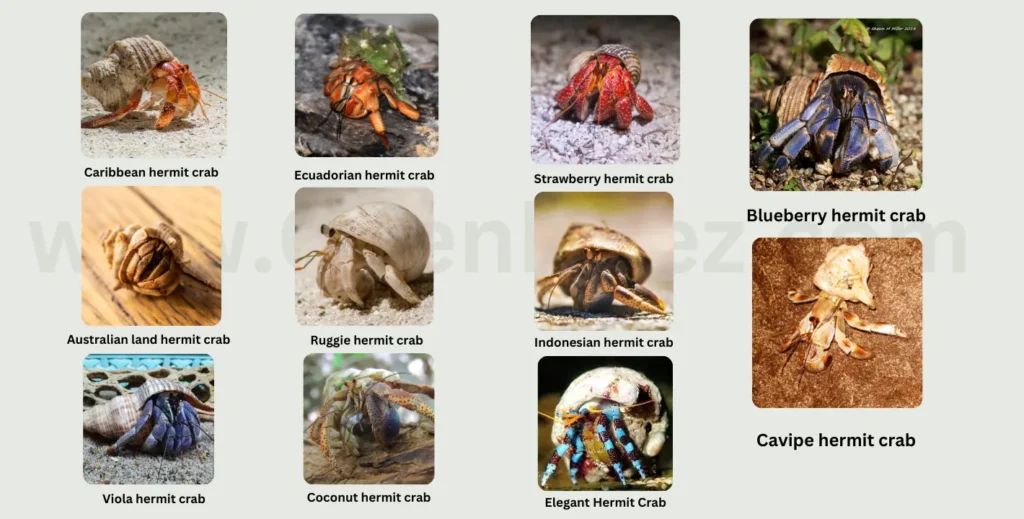
Here is the list of the most popular land hermit crabs:
1.Caribbean hermit crab (Coenobita clypeatus)
Caribbeans! One of the widely preferred types of hermit crabs for aquariums. Almost 70% of hermit crab lovers keep it in their tank. It’s a scavenger and a herbivore at the same time.
According to the sources of the National Museum of Natural History on the Source platform, the great Caribbean hermit crabs are natives of entire Caribbean regions, especially shores. You can call them soldier crabs because they migrate in thousands of numbers from woods to sea. Their motive is to lay eggs in the seawater.
2.Ecuadorian hermit crab (Coenobita compressus)
According to the report of the iNaturalist UK Organization, Ecuadorian hermit crabs are commonly called Pacific hermit crabs. They are one of the most popular types of hermit crabs because they are listed as the smallest species of hermit crabs. The University of South Florida at Digital Commons forum states that their length is only 12 mm (0.47 in).
Those who keep Ecuadorian hermit crabs state that these types of crabs walk fast and quickly, even faster than Caribbean hermit crabs. It seems like these hermit crab pets are quite active in their habitat. They come in a variety of colors like bright yellow, dark gray, orange, and tan (and some have blue or green tints to their bodies and legs).
3.Strawberry hermit crab (Coenobita perlatus)
Strawberry hermit crabs are another popularly farmed type of hermit crabs. These terrestrial hermies are not more than 6 to 7 inches long and weigh around 3.5-4 ounces. Interestingly, these cute crabs are mostly active at night.
If you are looking for a beautiful type of hermit crabs, go for strawberry hermit crabs. They are safe, clean, and easy to handle. Most importantly, they can live a longer life. So, you’ll never get sad because you can make them your friends for a longer time (30 to 40 years).
4.Blueberry hermit crab (Coenobita purpureus)
According to my Reddit fellows, blueberry hermit crabs are highly protected types of hermit crabs. You cannot buy them if you don’t live in Japan because these are only found there. No other nation owns these beautiful babies!
The Hermit Crab Association fellows also described its characteristics. They are pretty active and friendly. However, they can go crazy sometimes and trash your tank. They even eat blueberries and other fruits!
Look at this YouTube video of a blueberry hermit crab. It’s superbly cute and innocent. I love watching it moving here and there.
5.Australian land hermit crab (Coenobita variabilis)
The Australian land hermit crab is a fascinating terrestrial species of hermit crabs. It is commonly found along the coastal regions of Australia, from where it got its name. Moreover, these crabs have a diverse range of colors and patterns, often showcasing hues of red, brown, and purple on their bodies.
Their size ranges from small to medium (typically measuring between 2 to 4 inches in length). So, they are a popular choice among hermit crab enthusiasts due to their appropriate size. Remember, Australian land hermit crabs require a mix of saltwater and freshwater to thrive on land.
6.Ruggie hermit crab (Coenobita rugosus)
The Ruggie Hermit Crab is another robust and resilient species of hermit crabs. They are found in various tropical regions, including parts of Africa and Asia. Here is an interesting fact about them – these hermies are characterized by their rugged and textured exoskeleton.
Basically, their rugged exoskeleton provides them with excellent camouflage in rocky coastal habitats. Also, Ruggie Hermit Crabs are a favorite choice for hermit crab enthusiasts. Curious…why? This is because they are known for their adaptability and resourcefulness.
7.Indonesian hermit crab (Coenobita brevimanus)
The Indonesian Hermit Crab is native to the tropical regions of Indonesia and neighboring Southeast Asian countries. These cuties are distinguished by their vibrant colors and agile movements. That’s why they are a popular choice among aquarists and hobbyists.
Their size ranges between 2 to 4 inches in length. So, they are well-suited for both beginner and experienced hermit crab keepers. Keep in your mind, that Indonesian Hermit Crabs thrive in warm and humid environments. It means they require saltwater and freshwater to survive in their habitat.
8.Cavipe hermit crab (Coenobita cavipes)
If you are looking for one of the charming terrestrial types of hermit crabs, look for a Cavipe hermit crab in the pet stores. It is commonly found in coastal regions across Southeast Asia and the Pacific islands.
Cavipe Hermit Crabs thrive in tropical climates and these hermit crabs are recognized for their distinctive claw morphology. It means their one claw is significantly larger than the other which helps them in defense and feeding.
9.Viola hermit crab (Coenobita violascens)
Viola hermit crabs – named for their beautiful violet or purple hues. This characteristic adorns their exoskeleton and makes them a sought-after addition to your aquariums and terrariums.
Interestingly, they are known for their social nature. Most often they try to show intriguing behaviors within their colonies. Sometimes strange!
10.Coconut hermit crab (Birgus latro)
Coconut hermit crabs (commonly recognized as palm thieves or robber crabs) are giant species of hermit crabs. They are included in terrestrial hermit crabs and they weigh around 1 to 4.1 kg when it’s fully grown. What a giant Hermie!
Due to its large size and delicious meat, people hunt it extensively and consume it. According to the folks where it is hunted ruthlessly, “it is consumed as a delicacy.” It is important to consider the fact that the population of coconut hermit crabs is threatened due to extensive hunting.
11.Elegant Hermit Crab (Coenobita rugosus)
The natives of Hawaii know the truth that they are elegantly pretty types of hermit crabs. Moreover, aquarists value them so much due to their graceful behavior and intriguing movements.
These fascinating little creatures require a mix of saltwater and freshwater sources for hydration and survival. If you want to add them to your aquarium, you should feel peaceful after making your decision.
Most Common Types/Species of Hermit Crabs Kept As Pets:
In the marine aquarium trade, many species that fall under aquatic hermit crabs are traded every day. And do you know where they are kept? In the reef fish tanks!
Approximately 15 terrestrial/land species of the hermit crabs of the genus “Coenobita” exist worldwide. Among them, commonly kept pets include the following:
- Caribbean hermit crab (Coenobita clypeatus)
- Australian land hermit crab (Coenobita variabilis)
- Ecuadorian hermit crab (Coenobita compressus)
I’m keeping a Caribbean hermit crab in my home and it is a nice friend. Less common species of the genus Coenobita include Coenobita brevimanus, Coenobita rugosus, Coenobita perlatus, and Coenobita cavipes. However, they are becoming increasingly available and popular as pets for hermit crab keepers and lovers.
Hermit crabs are sometimes seen as ‘throwaway pets’ because they are thought to live only a few months. However, species like Coenobita clypeatus can live up to 20 years with proper care. Some hermit crabs of this species have even exceeded 32 years of age.
FAQs’
What is the best pet hermit crab?
Purple hermit crabs and Caribbean hermit crabs are the best pet hermit crabs. They are stronger, smaller, and peaceful creatures. They don’t bother (abandon) their fellows in the tank.
How do I tell what type of hermit crab I have?
If you are trying to ID(ing) your hermit crabs, pay full attention to their eyes shape, and size. You can read my above-mentioned guide and find which one is yours. I have covered all of the widely exported pet species of hermit crabs.
What is the largest breed/type of hermit crabs?
Diogenes (giant hermit crabs) are the largest types of hermit crabs.
Conclusion
So, we have come to the point of saying goodbye after discussing all types of hermit crabs. We came to know that there are 800 to 1,000+ species of hermit crabs and scientists are researching their new species till now. So, wait for my next topic where I’ll come up with exciting news about various other types of hermit crabs (newly-diagnosed ones).
Stay connected till that time. Also, stay hydrated!
I hope this helps you. If you have any other questions, feel free to ask me. I will answer you happily! 😊

